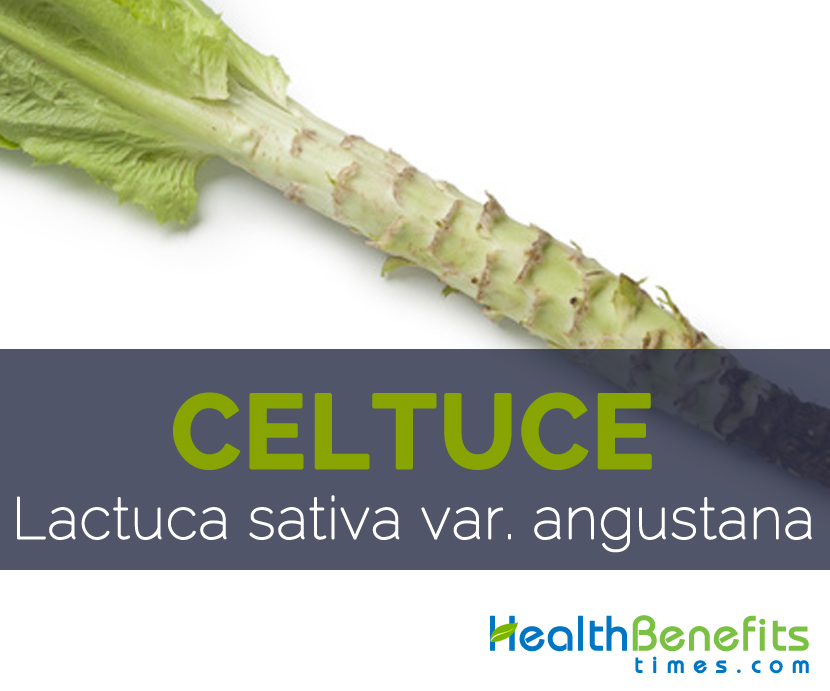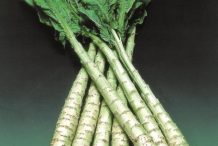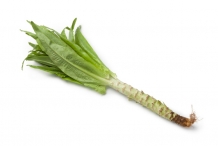This widely used crisp, moist, and mild flavor vegetable is a member in the Apiaceae ⁄ Umbelliferae family and Apium L. genus. Its scientific name is Lactuca sativa var. angustana.
Plant
Celtuce is an annual vegetable, which is defined as a plant that matures and ends its lifecycle over the course of a single year. Normal height of the plant is 25-30 cm and it grows in cool season in cool and moist locations and prefers well-drained, moist soil, deeply enriched with well-rotted manure. Stem is generally harvested at a length of about 15–20 cm and a diameter of around 3–4 cm. Celtuce have large butter head type, dark green, lime green and deep red leaves. Celtuce is usually quite a low maintenance plant and is generally very easy to grow – perfect for beginner gardeners! In China, where it is grown in commercial quantities, the fleshy stem is cut into sections and cooked by broiling or stewing. Leaves may be eaten in salads or as greens when they are young and tender but as they mature they grow bitter and become inedible.
Stem
Celtuce is generally grown in cool and moist locations for its soft, translucent green central core which can be used in salads, soups, and stir-fries, boiled or stewed. As soon as the stem reach the height of 15–20 cm and a diameter of around 3–4 cm it is harvested. Outer skin is peeled, removing the portion containing the bitter sap. Stem features woody skin. Soft, translucent green central core is the edible part which have crisp, moist, and mild flavor. Its taste is normally like a cross between lettuce and celery. They can be cooked just like broccoli and leaves can be used for salad.
History
Celtuce is actually a non-hearting relative of the lettuce, originating from southern China it was known as ‘Ou sen’. Later it was introduced into the western world during 1890’s and was originally identified as Asparagus Lettuce. Today, WōSŭn it is more often converted as Wo-ju, Wo Sun, or Wo-chu it is also known as celery lettuce, stem lettuce or Chinese lettuce as is extremely popular worldwide.
Nutritional Value
Apart from their taste like a cross between lettuce and celery. Celtuce is a good source of nutrients, vitamins and minerals. Consuming 100g of celtuce offers 0.688 mg of Manganese, 175 µg of Vitamin A, 19.5 mg of Vitamin C, 46 µg of Vitamin B9, 330 mg of Potassium, 0.55 mg of Iron and 28 mg of Magnesium. Moreover many Amino acids like 0.006 g of Tryptophan, 0.039 g of Threonine, 0.055 g of Isoleucine, 0.052 g of Leucine and 0.055 g of Lysine are also found in 100g of Celtuce.
Calories 18 Kcal. Calories from Fat 2.7 Kcal.
| Celtuce Quick Facts | |
|---|---|
| Name: | Celtuce |
| Scientific Name: | Lactuca sativa var. angustana |
| Origin | Southern China |
| Colors | Light Green |
| Shapes | Thick and tender stalks 15–20 cm and a diameter of around 3–4 cm |
| Taste | Cross between lettuce and celery |
| Calories | 18 Kcal./cup |
| Major nutrients | Manganese (29.91%) Vitamin A (25.00%) Vitamin C (21.67%) Vitamin B9 (11.50%) Potassium (7.02%) |
| Proximity | Amount | % DV |
|---|---|---|
| Water | 94.5 g | N/D |
| Energy | 18 Kcal | N/D |
| Energy | 75 kJ | N/D |
| Protein | 0.85 g | 1.70% |
| Total Fat (lipid) | 0.3 g | 0.86% |
| Ash | 0.7 g | N/D |
| Carbohydrate | 3.65 g | 2.81% |
| Total dietary Fiber | 1.7 g | 4.47% |
| Minerals | Amount | % DV |
|---|---|---|
| Calcium, Ca | 39 mg | 3.90% |
| Iron, Fe | 0.55 mg | 6.88% |
| Magnesium, Mg | 28 mg | 6.67% |
| Phosphorus, P | 39 mg | 5.57% |
| Potassium, K | 330 mg | 7.02% |
| Sodium, Na | 11 mg | 0.73% |
| Zinc, Zn | 0.27 mg | 2.45% |
| Copper, Cu | 0.04 mg | 4.44% |
| Manganese, Mn | 0.688 mg | 29.91% |
| Selenium, Se | 0.9 µg | 1.64% |
| Vitamins | Amount | % DV |
|---|---|---|
| Water soluble Vitamins | ||
| Vitamin B1 (Thiamin) | 0.055 mg | 4.58% |
| Vitamin B2 (Riboflavin) | 0.07 mg | 5.38% |
| Vitamin B3 (Niacin) | 0.55 mg | 3.44% |
| Vitamin B5 (Pantothenic acid) | 0.183 mg | 3.66% |
| Vitamin B6 (Pyridoxine) | 0.05 mg | 3.85% |
| Vitamin B9 (Folate, Folic acid) | 46 µg | 11.50% |
| Folate, DEF | 46 µg | N/D |
| Vitamin C (Ascorbic acid) | 19.5 mg | 21.67% |
| Fat soluble Vitamins | ||
| Vitamin A, RAE | 175 µg | 25.00% |
| Vitamin A, IU | 3500 IU | N/D |
| Lipids | Amount | % DV |
|---|---|---|
| Phytosterols | 11 mg | N/D |
| Amino Acids | Amount | % DV |
|---|---|---|
| Tryptophan | 0.006 g | 1.36% |
| Threonine | 0.039 g | 2.22% |
| Isoleucine | 0.055 g | 3.29% |
| Leucine | 0.052 g | 1.41% |
| Lysine | 0.055 g | 1.64% |
| Methionine | 0.01 g | N/D |
| Cystine | 0.01 g | N/D |
| Phenylalanine | 0.036 g | N/D |
| Tyrosine | 0.021 g | N/D |
| Valine | 0.046 g | 2.18% |
| Arginine | 0.046 g | N/D |
| Histidine | 0.015 g | 1.22% |
| Alanine | 0.037 g | N/D |
| Aspartic acid | 0.093 g | N/D |
| Glutamic acid | 0.119 g | N/D |
| Glycine | 0.037 g | N/D |
| Proline | 0.032 g | N/D |
| Serine | 0.026 g | N/D |





